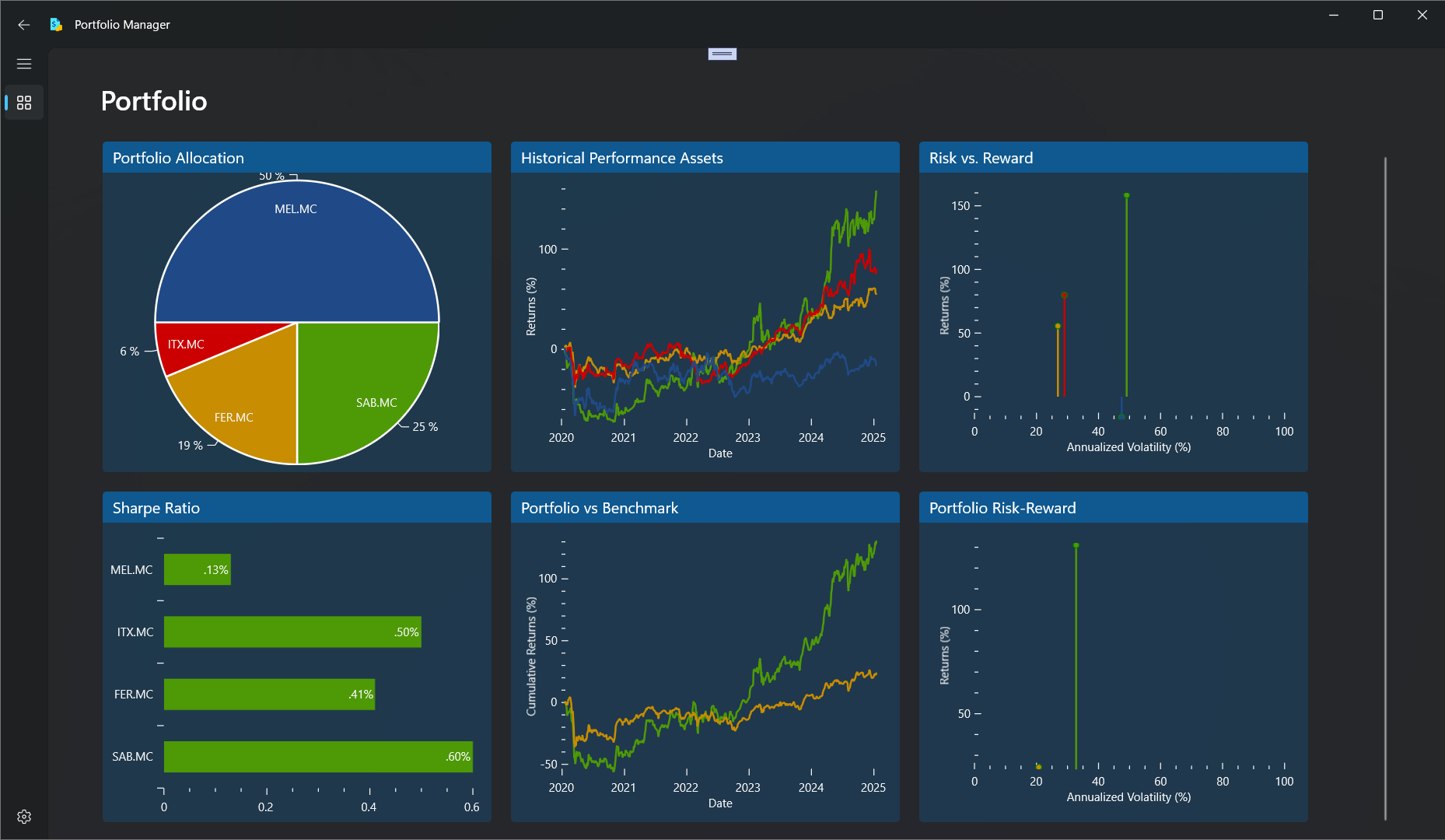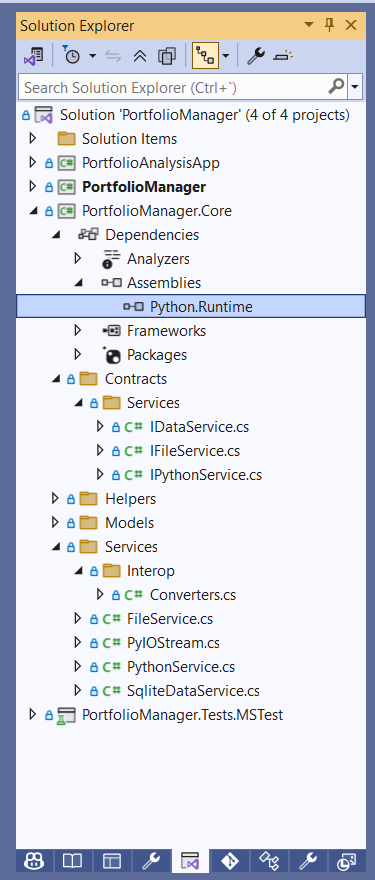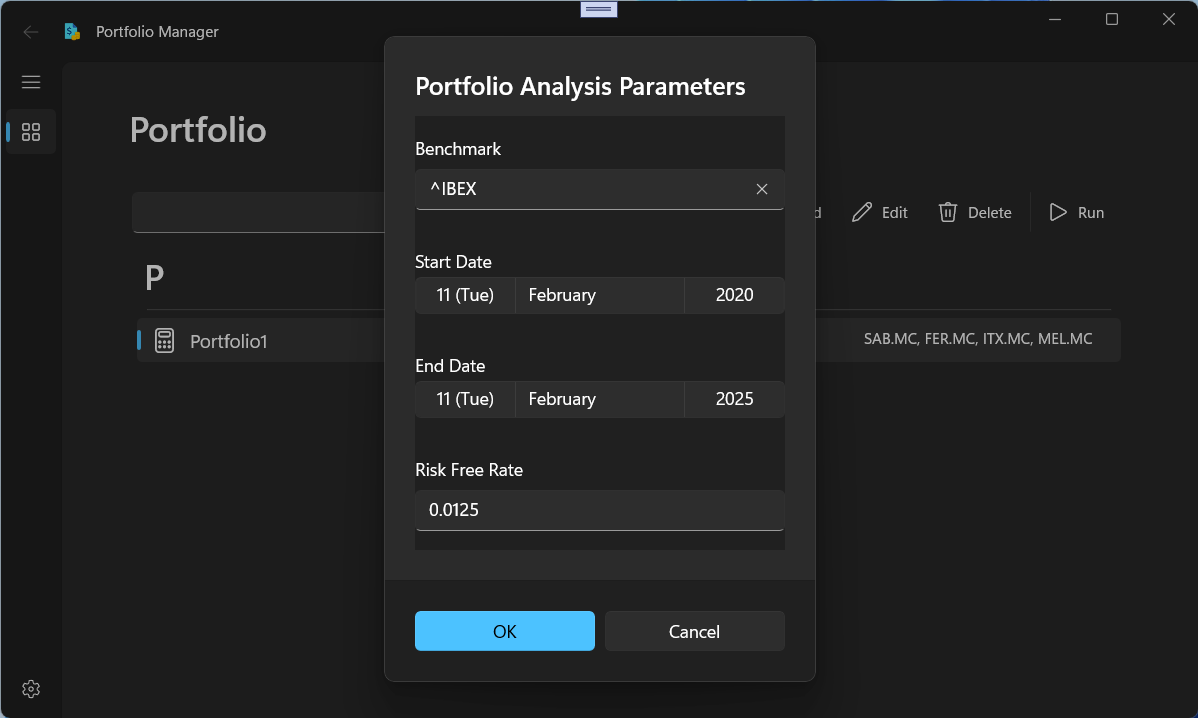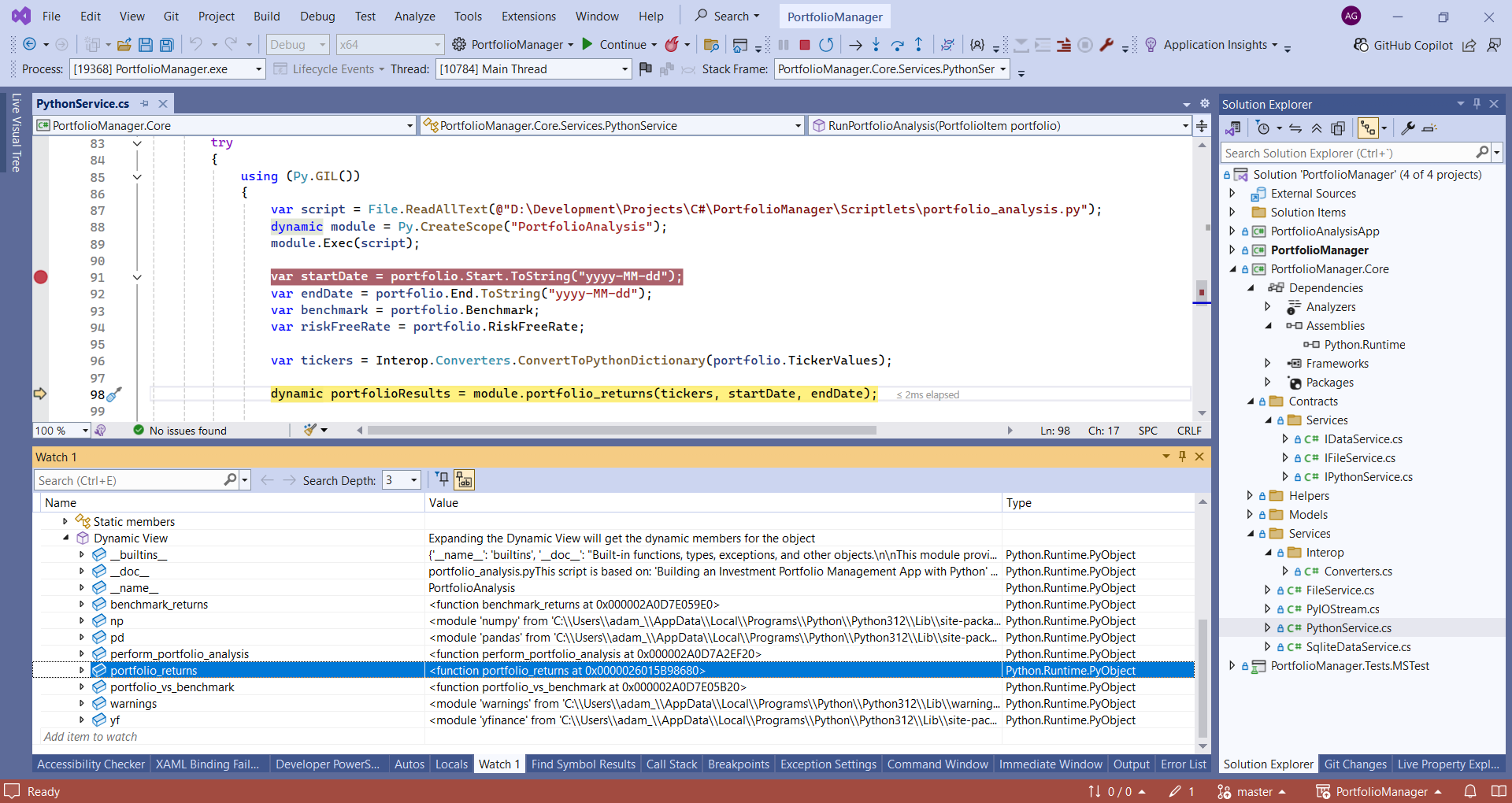Calling Python from C# using Python.NET
Introduction
Recently, I’ve been using Python’s yfinance library to perform some simple portfolio analysis. Rather than using a Jupyter notebook to run the Python code and visualise the results, I thought it might be a nice idea to build a .NET desktop application using WinUI 3.0, XAML and C#. The application allows you to define a portfolio and manages the presentation of the results graphically. The underlying analysis is performed using Python. In order to call the Python code from C#, I use Python.NET. The purpose of this blog post is to describe how to use Python.NET to call Python functions from a C# application. The complete PortfolioManager application is available on github.

The main advantage of this approach is that it allows access to Python’s extensive ecosystem from .NET. In this specific case, I wanted to build a simple portfolio management application while at the same time taking advantage of Python’s yfinance library to get the financial data I wanted and to use pandas and numpy to perform the calculations. I also wanted a slightly more real-world project using Python.NET. Information about this is somewhat limited and the examples are a little sketchy.
Versions
We use the following versions:
- Python 3.12
- yfinance 0.2.54
- Python.NET 3.0.5
The Python API
To start off, I wrote a simple portfolio analysis script. The script is based on a portfolio management app written in Python. However, I refactored the main functionality in order to separate the calculations and analysis from the (graphical) presentation layer. This allowed me to call the Python functions from C# to obtain the data and then process the (converted) data in the C# application.
The API consists of four functions.
-
portfolio_returns(ticker_values, start_date, end_date)This function takes the user-supplied tickers (and values), start date and end date. The function computes the ticker weights and obtains the adjusted close prices (if available) for each ticker using the yfinance library. The function returns a dictionary with the ticker weights, a DataFrame containing the individual ticker returns, and the overall portfolio returns. -
perform_portfolio_analysis(data, ticker_weights, risk_free_rate)This function takes the portfolio returns DataFrame computed previously, the ticker weights, and a user-supplied risk free rate and uses this to calculate individual security returns, cumulative returns, volatility, and Sharpe Ratios. These are returned in a dictionary. -
benchmark_returns(benchmark, start_date, end_date)This function obtains the benchmark data from yfinance using the supplied parameters. It also returns a dictionary. -
portfolio_vs_benchmark(port_returns, benchmark_returns, risk_free_rate)This function calculates the cumulative returns, annualized volatility, and Sharpe Ratios for both the portfolio and the benchmark using the data obtained in the previous functions. It provides a side-by-side comparison to assess the portfolio’s performance relative to the benchmark.
These four functions define the API that is used by the .NET application.
The .NET Application
Prerequisites
For the .NET application we first need to download and build Python.NET. The code is available from https://github.com/pythonnet/pythonnet. Once downloaded, open the solution file (pythonnet.sln), and select the Python.Runtime as the startup project. Then right-click and build the debug version. If the build is successful the Python.Runtime.dll will be located in the pythonnet directory under \pythonnet\runtime.
The PortfolioManager Application
Having built the Python.Runtime.dll, we need to add it to the Portfolio Manager application. This is a WinUI 3.0 (C#/XAML) application which makes use of the Windows Community Toolkit for dependency injection and the MVVM architecture. It also uses an Sqlite database to manage a collection of one or more portfolios.
Aside from the test framework (PortfolioManager.Tests.MSTest), the solution consists of two main projects: the PortfolioManager and PortfolioManager.Core. The PortfolioManager project deals with the application logic, user settings, the views and the view models. The reusable logic and data models are located in the PortfolioManager.Core project. So we add the Python.Runtime.dll to the Dependencies here under the Assemblies node.

The Python service
In the core library, we define a simple IPythonService interface that encapsulates the initialisation and the calls to the Python API.
public interface IPythonService
{
void Initialize(string pythonDll);
bool RunPortfolioAnalysis(PortfolioItem portfolio);
}
In the PortfolioManager project, in the App.xaml.cs, we add the IPythonService to the list of services to be activated
...
services.AddSingleton<IPythonService, PythonService>();
Finally, we pass an instance of the IPythonService into the PortfolioDetailViewModel. This view model manages the graphs output as a result of running the portfolio analysis. When the view is activated after clicking on the ‘Run’ button, the PythonService can be initialised and the view model can run the portfolio analysis based on the selected portfolio.
public PortfolioDetailViewModel(IPythonService pythonService)
{
_pythonService = pythonService;
var settings = App.GetService<SettingsViewModel>();
var pythonDll = settings.PythonLibrary;
_pythonService.Initialize(pythonDll);
//...
}
Initialisation of the PythonService consists of setting the path to the Python dll. This is configured via the application settings page. Additionally, we set up a couple of empty output streams to redirect any console output from the Python.Runtime.
Portfolio Analysis
The main function RunPortfolioAnalysis is called with the currently selected PortfolioItem. The PortfolioItem contains the user supplied parameters which have been obtained from the UI.

The RunPortfolioAnalysis function loads the portfolio_analysis.py script and passes it to Python.NET, which creates a Python module object. The module object is used to access the script functions and variables. We use C#’s ‘dynamic’ keyword to delay the binding. We can see the available dynamically bound functions and parameters if we expand the module variable in the Watch window.

The portfolio analysis proceeds by calling the Python functions using the user-supplied parameters and any intermediate results. Once these have been appropriately converted they are copied into the portfolio item’s data members.
...
dynamic portfolioResults = module.portfolio_returns(tickers, startDate, endDate);
var pyTickerWeights = new PyDict(portfolioResults["weights"]);
portfolio.TickerWeights = Interop.Converters.ConvertTickerWeights(pyTickerWeights);
...
In this snippet, the Python object pyTickerWeights is extracted from the dictionary returned from calling module.portfolio_returns. The Python ‘dict’ is converted into a C# List<TickerWeight>. The ConvertTickerWeights function just iterates over each ticker and obtains the corresponding weight. This is then assigned to the TickerWeights member of the portfolio item. The TickerWeights list is then used in a Pie Chart that displays the percentage allocation of tickers in the portfolio.
Once the analysis is complete, the PortfolioDetailViewModel initialises the PlotModel with the data from the portfolio item, which then updates the graph view as it is bound to the specific PlotModel.
It is worth highlighting that the performance is quite slow. There seem to be two main aspects to this:
- The initialisation of the Python engine seems to take some time, and perhaps this could be done once at startup.
- The
PortfolioDetailViewModelrenders six graphs with different datasets serially. It seems to me that this might be better refactored to use C# asynchronous processing.
I am currently investigating both these issues.
The interop layer
This layer provides facilities to convert between C# and Python types. Basic types (strings, ints, doubles etc.) are converted transparently. From C#, we use the .ToPython() extension method to convert to a Python object. And from Python, we use the .AsManagedObject(typeof(T)) function to return a C# object which we can then cast. Converting from a pandas DataFrame or series can be somewhat more involved.
Wrap-up
This blog post has described how to call Python functions from a C# desktop application using Python.NET. This arrangement (WinUI 3.0 C# front-end, Python.NET and Python) has the advantage of flexibility. The approach is quite generalisable. I could just as easily have created a TensorFlow model and called it from a C# application, if that had been my interest. On the other hand, the main disadvantage is the slow performance. This is an area that I am still currently investigating.

Comments